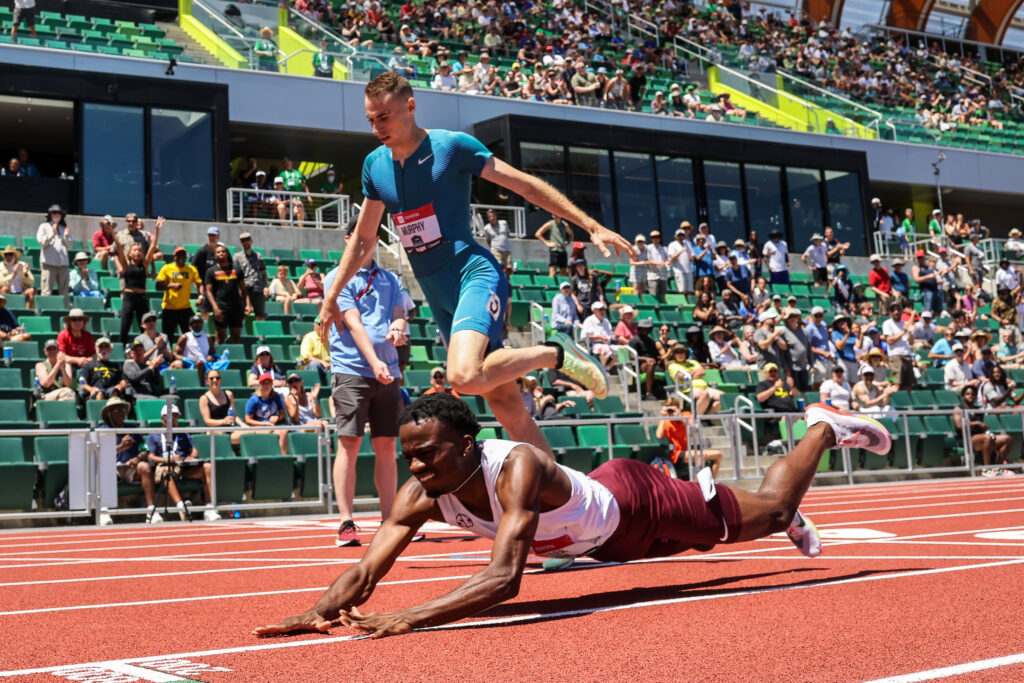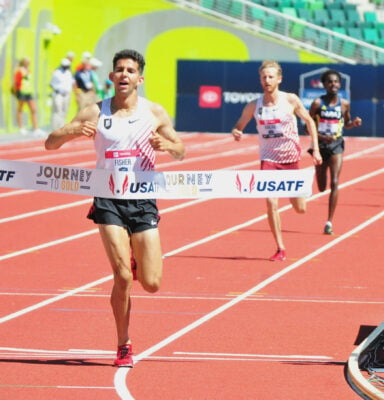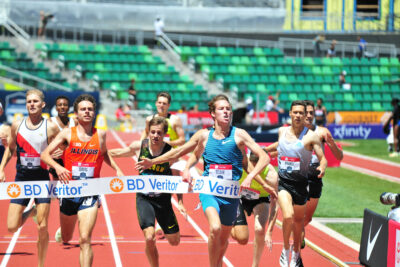World Athletics Announces Tougher Qualifying Standards for 2023 World Championships
By Jonathan Gault
August 19, 2022
On Friday, World Athletics announced the qualifying standards for the 2023 World Athletics Championships to be held in Budapest, Hungary, from August 19-27, 2023. As expected, the standards are significantly tougher in a number of events as World Athletics attempts to have fewer athletes qualify via standard and more via World Ranking (in the past, World Athletics has hoped for 50% of athletes to qualify via standard and 50% via World Ranking).
Some of the biggest drops came in the distance events. In 2022, the World Championship standards in the 5,000 and 10,000 meters were 13:13.50 and 27:28.00 for men and 15:10.00 and 31:25.00 for women. In 2023, the auto marks are now 13:07.00 and 27:10.00 for men and 14:57.00 and 30:40.00 for women.
World Athletics also announced that athletes will be able to use a mile time to qualify in the 1500 meters (3:51.00 and 4:22.00 for men and women, respectively) and that athletes can also use road times in the mile, 5K, and 10K to qualify for Worlds.
The qualifying window for most events for the 2023 Worlds runs from July 31, 2022 – July 30, 2023. For the 10,000, 20k race walk, and combined events, the window is January 31, 2022 – July 30, 2023. For the marathon and 35k race walk, the window is December 1, 2021 – May 30, 2023.
We’ve compared the full list of qualifying standards for the 2022 and 2023 Worlds below.
2023 Men’s World Athletics Qualifying Standards
| 2022 Worlds | Event | 2023 Worlds |
| 10.05 | 100m | 10.00 |
| 20.24 | 200m | 20.16 |
| 44.90 | 400m | 45.00 |
| 1:45.20 | 800m | 1:44.70 |
| 3:35.00 | 1500m | 3:34.20 (3:51.00/3:51) |
| 13:13.50 | 5000m | 13:07.00 (13:07) |
| 27:28.00 | 10,000m | 27:10.00 (27:10) |
| 2:11:30 | Marathon | 2:09:40 |
| 8:22.00 | 3000m SC | 8:15.00 |
| 13.32 | 110m H | 13.28 |
| 48.90 | 400m H | 48.70 |
| 2.33m | High jump | 2.32m |
| 5.80m | Pole vault | 5.81m |
| 8.22m | Long jump | 8.25m |
| 17.14m | Triple jump | 17.20m |
| 21.10m | Shot put | 21.40m |
| 66.00m | Discus | 67.00m |
| 77.50m | Hammer | 78.00m |
| 85.00m | Javelin | 85.20m |
| 8350 | Decathlon | 8460 |
| 1:21:00 | 20k RW | 1:20:10 |
| 2:33:00 | 35k RW | 2:29:40 |
2023 Women’s World Athletics Qualifying Standards
| 2022 Worlds | Event | 2023 Worlds |
| 11.15 | 100m | 11.08 |
| 22.80 | 200m | 22.60 |
| 51.35 | 400m | 51.00 |
| 1:59.50 | 800m | 1:59.80 |
| 4:04.20 | 1500m | 4:03.50 (4:22.00/4:22) |
| 15:10.00 | 5000m | 14:57.00 (14:57) |
| 31:25.00 | 10,000m | 30:40.00 (30:40) |
| 2:29:30 | Marathon | 2:28:00 |
| 9:30.00 | 3000m SC | 9:23.00 |
| 12.84 | 100m H | 12.78 |
| 55.40 | 400m H | 54.90 |
| 1.96m | High jump | 1.97m |
| 4.70m | Pole vault | 4.71m |
| 6.82m | Long jump | 6.85m |
| 14.32m | Triple jump | 14.52m |
| 18.50m | Shot put | 18.80m |
| 63.50m | Discus | 64.20m |
| 72.50m | Hammer | 73.60m |
| 64.00m | Javelin | 63.80m |
| 6420 | Heptathlon | 6480 |
| 1:31:00 | 20k RW | 1:29:20 |
| 2:54:00 | 35k RW | 2:51:30 |
So how tough are the new standards? We looked at the number of athletes worldwide and in the US who hit the new standards during the qualifying window for the 2022 World Championships (we didn’t factor in the three-athlete-per-country limit):
Number of men who hit the 2023 Worlds standards during qualifying period for 2022 Worlds
| Event | Standard | World | USA |
| 100m | 10.00 | 35 | 13 |
| 200m | 20.16 | 37 | 19 |
| 400m | 45.00 | 38 | 15 |
| 800m | 1:44.70 | 38 | 3 |
| 1500m | 3:34.20 (3:51.00/3:51) | 32 | 4 |
| 5000m | 13:07.00 (13:07) | 40 | 7 |
| 10,000m | 27:10.00 (27:10) | 24 | 1 |
| Marathon | 2:09:40 | 304 | 4 |
| 3000m SC | 8:15.00 | 23 | 1 |
| 110m H | 13.28 | 35 | 10 |
| 400m H | 48.70 | 23 | 9 |
| High jump | 2.32m | 12 | 4 |
| Pole vault | 5.81m | 23 | 6 |
| Long jump | 8.25m | 14 | 4 |
| Triple jump | 17.20m | 14 | 3 |
| Shot put | 21.40m | 18 | 7 |
| Discus | 67.00m | 10 | 1 |
| Hammer | 78.00m | 16 | 2 |
| Javelin | 85.20m | 12 | 1 |
| Decathlon | 8460 | 10 | 4 |
| 20k RW | 1:20:10 | 32 | 0 |
| 35k RW | 2:29:40 | 11 | 0 |
Number of women who hit the 2023 Worlds standards during qualifying period for 2022 Worlds
| Event | Standard | World | USA |
| 100m | 11.08 | 56 | 22 |
| 200m | 22.60 | 46 | 17 |
| 400m | 51.00 | 41 | 14 |
| 800m | 1:59.80 | 46 | 16 |
| 1500m | 4:03.50 (4:22.00/4:22) | 49 | 11 |
| 5000m | 14:57.00 (14:57) | 57 | 7 |
| 10,000m | 30:40.00 (30:40) | 27 | 1 |
| Marathon | 2:28:00 | 208 | 8 |
| 3000m SC | 9:23.00 | 28 | 5 |
| 100m H | 12.78 | 41 | 18 |
| 400m H | 54.90 | 27 | 8 |
| High jump | 1.97m | 11 | 1 |
| Pole vault | 4.71m | 12 | 4 |
| Long jump | 6.85m | 12 | 3 |
| Triple jump | 14.52m | 14 | 3 |
| Shot put | 18.80m | 22 | 6 |
| Discus | 64.20m | 10 | 3 |
| Hammer | 73.60m | 17 | 4 |
| Javelin | 63.80m | 13 | 2 |
| Heptathlon | 6480 | 8 | 3 |
| 20k RW | 1:29:20 | 32 | 0 |
| 35k RW | 2:51:30 | 30 | 1 |
Quick Takes
American men are going to have a tough time hitting the new standards in the distance events
Here are the men who hit the 2023 Worlds standard during the qualifying period for the 2022 Worlds:
800 (3): Clayton Murphy, Isaiah Harris, Bryce Hoppel
1500 (4): Cole Hocker, Colby Alexander, Matthew Centrowitz, Cooper Teare
5000 (7): Paul Chelimo, Grant Fisher, Joe Klecker, Abdihamid Nur, Woody Kincaid, Cooper Teare, Emmanuel Bor
10,000 (1): Grant Fisher
Steeple (1): Hillary Bor
Having a new target to shoot at could lead to an extra standard or two for the 2023 cycle as races will be paced for the new standards. But not many more. For instance, only five Americans in history have ever broken 27:10 in the 10,000.
On the women’s side, it’s not as big of an issue as 16 Americans ran 1:59.80 or faster during the 2022 qualifying window to hit the new 800 standard, 11 hit the new 1500 standard, 7 hit the new 5000 standard, and 5 hit the new steeple standard. In the 10,000, however, Elise Cranny was the only woman to hit the new 30:40 standard, and only four American women have ever run that fast.
For most distance events, the US should still be able to send a full complement of athletes as they will have enough athletes ranked highly enough in the World Rankings. The one exception could be the 10,000 meters. Because it’s a straight final, the field size is smaller (27 athletes). Plus World Athletics is creating a quota of eight athletes who can qualify in the 10,000 based on their World Ranking in cross country. So American 10,000 runners will have to keep a close eye on their World Ranking to see if they’re in line to qualify.
All this leads us to our next point…
It’s time to implement a quota system for federations that have 3+ qualifiers in an event to let them send the top 3 from the national championships
We’ve been beating the drum for this at LetsRun.com for years, and with the standards only getting harder to hit, it’s time to say it again: if a country is deep enough to have three athletes qualify for Worlds (especially if they hit the auto standard), that country should be able to send the top three from its national championships to Worlds.
Let’s look at this year’s US men’s 1500 final. The US had six men with the auto standard for Worlds, but only one of them, Cooper Teare, finished in the top 3 at USAs. Once the race was over, no one knew who was on the World Championship team. The runner-up Jonathan Davis wasn’t celebrating because he knew he wasn’t on the team. And sixth-placer Johnny Gregorek — who was on the team — didn’t celebrate either because he wasn’t certain of where he stood compared to the guys that beat him. That’s not how things should be.
The US championships are one of the few meets that truly matter on the schedule. And the meet works well because, in most events, it’s pretty simple: the top three finishers make the team. By making the auto standards harder and harder, World Athletics is ensuring we’ll see fewer and fewer races with that cut-and-dried simplicity. World Athletics’ goal in incorporating the World Rankings is to create more meaningful races. But the side effect is it could make USAs less meaningful and more confusing. Is that what World Athletics wants for the country it says is most important for its growth?
The fix is simple. If a federation is going to be sending three athletes to Worlds anyway, let them pick the top three from their national championships.
The problem is, World Athletics’ current ranking system is flawed. It treats all national championships the same. So USA nationals has the same ranking as the Belize nationals and the same ranking as the Music City Track Carnival. That is nuts. The ranking system needs to change or a quota system needs to be implemented.
Just look at what happened to Jonathan Davis this year. He finished 2nd at USAs, but didn’t have the qualifying standard or a high enough World Ranking. Three weeks later, he ran 3:33.81 to hit the standard, but by then it was too late. But we already knew he was good enough to run at Worlds because he finished 2nd at USAs. We need to avoid scenarios like that moving forward.
You can now use a mile time to qualify in the 1500…and road times to qualify in the 1500, 5,000, and 10,000
Thumbs up to World Athletics for allowing 1500 athletes to use a mile time to qualify for Worlds. It’s a little hard to believe you couldn’t do that before, but the mile is run regularly enough that this decision makes a lot of sense.
Using times for a road mile to qualify for the 1500 at Worlds — which is also allowed now — is a bit questionable as you can easily pick up a few extra seconds with a big tailwind. But there is a rule saying road mile courses can’t have an elevation drop of more than 1.6 meters so athletes can’t use a fast downhill time to qualify. Allowing 5k and 10k road times to qualify in the 5,000 and 10,000 makes sense, especially given the dearth of fast track 10,000 races on the track. If you can run faster than 13:07 or 27:10 on the roads, you’re definitely good enough to run at Worlds.



